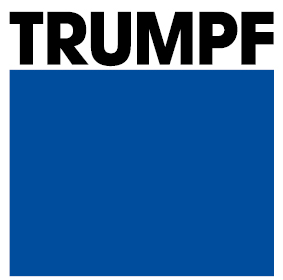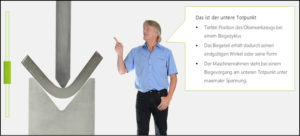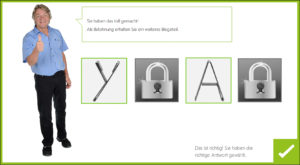The challenge facing TRUMPF Maschinen Austria GmbH was to convey complex technical content as eTraining tailored to the target group. The project was developed in close cooperation with the trainers of the classroom training, in order to perfectly coordinate the two cornerstones “eTraining” and “classroom training” in terms of content and methodology.
 The eTrainings are primarily addressed to all TRUMPF service technicians for bending machines worldwide. In order to bring all training participants up to the same level of knowledge before the presentation training, the idea for self-organized online training was born. In addition, the eTrainings can be used by new employees, marketing staff, customers and other interested persons.
The eTrainings are primarily addressed to all TRUMPF service technicians for bending machines worldwide. In order to bring all training participants up to the same level of knowledge before the presentation training, the idea for self-organized online training was born. In addition, the eTrainings can be used by new employees, marketing staff, customers and other interested persons.
The most important innovation for the company is the establishment of a new learning culture through eTraining. With the help of Flipped Teachings the knowledge recruiter takes place before the operational readiness level training courses. If questions or comprehension problems arise, it is still possible to ask questions during the learning phase. This enables trainees to learn at their own pace without having to take fellow learners into account. The advance of the learning time for basic knowledge brings more time for exercises in the presence phases and enables targeted coaching by the trainers. Accompanied exercises, which are carried out as independently as possible by the learners, link the content learned in an application-oriented and competence-oriented manner. Overall, the service technician is better prepared for the actual work after the classroom training than would have been possible without the eTraining in the same training period. Integrated learning not only improves training, but also challenges and promotes the self-learning skills of employees.
In addition, the following criteria for successful e-learning in the project were identified and taken into account:
Creating authenticity

Both TRUMPF employees and customers are target groups for eTraining. For both target groups it is important to create authenticity. The eTrainings should not at any time convey arbitrariness. The “Technology of Bending” project is particularly characterized by the personalization of the modules. An avatar leads through the module – he is actually a TRUMPF employee and a well-known team member of the training department. The following face-to-face training courses will also be held by him. It symbolizes the entanglement of real and virtual knowledge mediator. The Avatar provides learners with a social anchor during the entire training phase. The avatar aims at a high identification with the learning content, as well as in general with the company. It is also used to generate greater concentration and attention as the avatar interacts with the learner. It asks questions to be answered, provides feedback and supports important information. Determining the learner’s name at the beginning of the module leads to an even more intensive personalization of the modules. It will become an essential vehicle for the dramaturgy of the eTrainings.
The rewards also refer to bending technology, the core competence of TRUMPF Maschinen Austria. The letters of the word Yeah were bent on TRUMPF bending machines. The authenticity factor is thus maintained during the eTraining. It leads to a positive acceptance of online trainings and contributes to a stronger identification with the company.
Modularity
The complexity of the content increases from module to module. However, the learner can freely choose which modules are to be processed. You can also navigate freely within a module. Each module contains a quiz, on the basis of which the learned knowledge can be checked and if necessary knowledge deficits can be localized. The learners who will subsequently attend the classroom training course must successfully pass the final test. The final test contains any excerpt from the quiz questions of the individual modules.
Interactions
There is a great focus on interaction in the different modules. The eTrainings should clearly stand out from boring Powerpoint-based formats. The learner is encouraged to participate and content can be actively developed. For example, interactive videos have been built in, appropriate information texts are displayed at the right time and the learner can control the timing himself. Other interactive elements used are sliders, buttons, markers, zoom areas and hotspots.
Gamification

Besides the preparation with as many visual and interactive elements as possible, gamification elements loosen up the learning of this technically complex content. There are 4 questions per module. Each of these questions can be answered as often as you like. If the answer is correct, the learner receives a so-called bent part. The goal is to get the lettering “YEAH”. This lettering is multilingual and can therefore also be used in all other language conversions. Answering the questions is not obligatory, they can be called up and answered in any order.
Ensure learning success
TRUMPF eTraining’s learning transfer was ensured in 3 steps:
During the acquisition phase: By maintaining repetition of the learning contents, targeted practice and elaboration of knowledge through categorization and connection to the previous knowledge, the contents are better anchored in the memory. The learning units are always a maximum of 30 minutes long in order to make optimum use of the learners’ learning capacities. Longer sessions may have to be interrupted and then resumed.
1. Quantitative method: Testing of the contents in the final test. The success rate of the test reveals whether the knowledge learned can be correctly reproduced.
2. Qualitative procedure: The trainers observe and assess in the face-to-face training courses whether the acquired knowledge can be applied in practice assignments and whether it can be conclusively integrated into everyday working life.
Focus on mobile learning
Mobile first is TRUMPF’s program, so all content has been optimized for mobile devices. Learners can determine the learning device themselves. Since responsive implementation entails many restrictions in the creative preparation of the content, it was dispensed with. Rather, care was taken to ensure that all content elements were easy to read and operate even when mobile. The integrated player of Articulate Storyline 3 ensures that wiping gestures are also supported.
Marketing
Since these eTrainings provide basic knowledge on the subject of bending, these are not only an obligatory component of the of the face-to-face training courses, but for all employees of the Group are of relevance. In order to promote dissemination, the following measures were carried out:
- Publication of the freely accessible modules in the LMS
- Internal e-mail to all employees
- Newsletter to all already in the LMS registered user
- Announcement to all trainers of the TRUMPF companies
- Group-wide news article in the Intranet
Recap
The main goal of bringing the knowledge of TRUMPF service technicians for bending machines worldwide up to the same level has been achieved. This makes classroom training more efficient, more detailed and leaves more time for practical exercises. Travel costs are also saved. The eTrainings increase the quality of training and further education.
The Author
 Christa Furtmüller
Christa Furtmüller
is E-Learning Project Manager at TRUMPF Maschinen Austria GmbH in Pasching. The location is the competence center for bending in the TRUMPF Group. She holds a degree in “Engineering for Computer-based Learning” and is the contact person at TRUMPF Austria for all media literacy agendas with a focus on e-learning.
Contact:
Contact person:
Christa Furtmüller
eSolutions
Industriepark 24
A-4061 Pasching
Phone: +43 (0) 7221 / 60 3-0
Fax: +43 (0) 7221 / 60 3-42050
info@at.trumpf.com
www.trumpf.com





